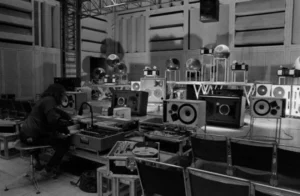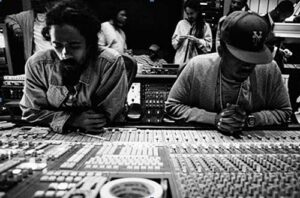By Roktima Godhuli
As the honorable Black History Month comes to a close, there is one great musical technique that should be discussed: sampling.
The Basics—What Is Sampling?
Sampling, in music, is a process by which a portion of preexisting audio from a different source is recontextualized through careful selection, recording, editing, and processing for a substantially new recording. Sampled music can be created by spinning records on turntables, splicing audio tapes together, or musicians using digital samplers in a program. Sampling remains a foundational technique in contemporary genres like hip-hop and EDM, but its origin traces back to those days of audio tape.
Origins of Sampling—Looping Tapes & Digging Crates
In the early 1900s, jazz musicians often “sampled” parts of melodies, hooks, licks, and progressions from their peers’ compositions during live performances. Their antics served as an inside joke between musicians and made jazz shows more fun for the audience. By the 1940s, the emergence of a new genre named “Musique Concrete” was led by French composer Pierre Schaeffer. This type of music utilized recordings as raw material. The samplings were manipulated by being looped, pitch-shifted, sped and slowed up or down, or repurposed. The 1960s saw Jamaican dub reggae artists use vocal samples to produce riddim tracks. By the 1970s, early American hip-hop producers and rappers were incorporating looping and sampling into their nascent art form. Fast forward to the 1970s-80s. Sampling was pioneered within African-American communities throughout New York, with producers sampling funk and soul records.

How to do it?—Sampling Techniques
Sampling music can be made in many ways. Layering, where multiple samples are combined in layers and played simultaneously, achieves rich, intricate, and rhythmic melodies. There is also changing the tempo, time stretching, and pitch shifting. Equalization is the process of tweaking levels of frequencies to achieve a clear, balanced mix. You can also reverse, resample, and use one shots. Nowadays, you can split a song into separate audio files like drums and vocals, known as stem splitting.
Heart of Sampling—Cultural Significances
Sampling techniques reflect narrative originality in oral cultures as they used to make up stories by combining old formulas and themes instead of devising new ones. The practice of sampling in hip-hop, rap, and electronic music is a contemporary demonstration of folk music traditions. Sampling is deeply ingrained in African American and Afro-Caribbean cultures as they descended from the traditionally oral societies of Africa. Sample-based music is a manifestation of those folk ideals. These traditions reflected in sample-based music have been passed on through generations and form the foundation of musicians’ creativity and talent.
Although sampling has been around before the conception of hip hop as a genre, it has always been a polarizing subject in the music industry. Evaluating sampling in a scholarly framework of Western artistic movements and ideals fails to recognize it for what it originally was: a folk tradition that emerged from the shared experiences of economically disadvantaged minorities. Hip-hop sampling is not exceptional. It arose as a result of oppressive socioeconomic conditions in America and technological advances in affordable musical instruments, resulting in a transformation in art and music. Sampling is used as a method of narrative reformulation and resistance by people of color, especially by African Americans. Rap artists challenge institutional apparatuses that define property, technological innovation, and authorship by redefining the constitution of narrative originality, composition, and collective memory. In the words of Lauryn Hill, ‘Hip-hop was born through people who didn’t necessarily have traditional musical training, the best tools, and in some cases even instruments, but found a way to express themselves despite that.’


